Rhythm of Exposure in Town Centres: A Case Study of Lancaster City Centre
Abstract
1. Introduction
2. Data and Methods
2.1. Site Description: Lancaster—Cable Street and Dalton Square
2.2. Air Quality Monitoring
2.3. Population Flow
2.4. Air Quality Exposure Index
2.4.1. Setting out the Metric’s Stages and Parameters
2.4.2. Traffic and Pedestrian Parameters
- Motorways are the highest class of roads and are designed for fast-moving long-distance traffic. These roads handle very high traffic volumes of up to 100,000 vehicles per day or even more on the busiest sections.
- A roads are major urban routes that can be either primary or non-primary. Primary A roads can carry high traffic volumes of up to 50,000 vehicles per day, while non-primary A roads have less traffic than primary A roads and typically handle traffic of up to 20,000 vehicles per day.
- B roads are less significant than A roads and primarily serve to connect smaller towns and local destinations. These roads generally carry lower traffic volumes, usually up to 10,000 vehicles per day.
- C roads are important but smaller routes maintained by local authorities and often serve smaller towns and residential areas. These roads handle even smaller traffic volumes, typically under 5000 vehicles per day.
- Unclassified roads are minor roads intended for local traffic within towns and villages, including residential streets, rural roads and other minor roads. These roads usually have a very low traffic volumes, typically no more than 1000 vehicles per day.
2.4.3. Air Quality Parameter
2.4.4. Air Pollution Exposure Index Framework
3. Results
3.1. Rhythm of the Public Space
3.1.1. Cable Street
3.1.2. Dalton Square vs. Cable Street
3.2. Rhythm of Pollution Concentration
3.2.1. Cable Street
3.2.2. Dalton Square vs. Cable Street
3.3. Weighted Air Pollution Exposure (WAPE)
3.4. Population Exposure Rhythms
3.4.1. Cable Street
3.4.2. Dalton Square vs. Cable Street
4. Discussion and Conclusions
Author Contributions
Funding
Data Availability Statement
Acknowledgments
Conflicts of Interest
References
- Atkinson, R.W.; Mills, I.C.; Walton, H.A.; Anderson, H.R. Fine particle components and health—A systematic review and meta-analysis of epidemiological time series studies of daily mortality and hospital admissions. J. Expo. Sci. Environ. Epidemiol. 2015, 25, 208–214. [Google Scholar] [CrossRef] [PubMed]
- Burnett, R.; Chen, H.; Szyszkowicz, M.; Fann, N.; Hubbell, B.; Pope, C.A., 3rd; Apte, J.S.; Brauer, M.; Cohen, A.; Weichenthal, S.; et al. Global estimates of mortality associated with long-term exposure to outdoor fine particulate matter. Proc. Natl. Acad. Sci. USA 2018, 115, 9592–9597. [Google Scholar] [CrossRef] [PubMed]
- Cohen, A.J.; Brauer, M.; Burnett, R.; Anderson, H.R.; Frostad, J.; Estep, K.; Balakrishnan, K.; Brunekreef, B.; Dandona, L.; Dandona, R.; et al. Estimates and 25-year trends of the global burden of disease attributable to ambient air pollution: An analysis of data from the Global Burden of Diseases Study 2015. Lancet 2017, 389, 1907–1918. [Google Scholar] [CrossRef]
- Committee on the Medical Effects of Air Pollutants; Ayres, J.G.; Health Protection Agency. The Mortality Effects of Long-Term Exposure to Particulate Air Pollution in the United Kingdom; Health Protection Agency: London, UK, 2010. Available online: https://assets.publishing.service.gov.uk/media/5a7e2f4640f0b62302689b57/COMEAP_mortality_effects_of_long_term_exposure.pdf (accessed on 11 February 2021).
- Gowers, A.M.; Miller, B.G.; Stedmant, J.R. Estimating Local Mortality Burdens Associated with Particulate Air Pollution; Centre for Radiation, Chemical and Environmental Hazards, Public Health England, Chilton, Didcot: Oxfordshire, UK, 2014. Available online: https://assets.publishing.service.gov.uk/media/5a7d7b17ed915d269ba8aecd/PHE_CRCE_010.pdf (accessed on 14 September 2022).
- GBD 2019 Risk Factors Collaborators. Global burden of 87 risk factors in 204 countries and territories, 1990–2019: A systematic analysis for the Global Burden of Disease Study 2019. Lancet 2020, 396, 1223–1249. [Google Scholar] [CrossRef]
- World Health Organisation—WHO. Ambient Air Pollution: A Global Assessment of Exposure and Burden of Disease. 2016. Available online: http://www.who.int/phe/health_topics/outdoorair/databases/cities/en (accessed on 14 August 2022).
- Brunekreef, B.; Holgate, S.T. Air pollution and health. Lancet 2002, 360, 1233–1242. [Google Scholar] [CrossRef] [PubMed]
- Beelen, R.; Hoek, G.; Fischer, P.; van den Brandt, P.A.; Brunekeef, B. Estimated long-term outdoor air pollution concentrations in a cohort study. Atmos. Environ. 2007, 41, 1343–1351. [Google Scholar] [CrossRef]
- Beelen, R.; Raaschou-Nielsen, O.; Stafoggia, M.; Andersen, Z.J.; Weinmayr, G.; Hoffmann, B.; Wolf, K.; Samoli, E.; Fischer, P.; Nieuwenhuijsen, M.; et al. Effects of long-term exposure to air pollution on natural-cause mortality: An analysis of 22 European cohorts within the multicentre ESCAPE project. Lancet 2014, 383, 785–795. [Google Scholar] [CrossRef] [PubMed]
- Khreis, H.; May, A.D.; Nieuwenhuijsen, M.J. Health impacts of urban transport policy measures: A guidance for practice. J. Transp. Health 2017, 6, 209–227. [Google Scholar] [CrossRef]
- Ott, W. Concepts of human exposure to air pollution. Environ. Int. 1982, 7, 179–196. [Google Scholar] [CrossRef]
- Tang, R.; Tian, L.; Thach, T.-Q.; Tsui, T.H.; Brauer, M.; Lee, M.; Allen, R.; Yuchi, W.; Lai, P.-C.; Wong, P. Integrating travel behaviour with land use regression to estimate dynamic air pollution exposure in Hong Kong. Environ. Int. 2018, 113, 100–108. [Google Scholar] [CrossRef] [PubMed]
- Molter, A.; Lindley, S.; de Vocht, F.; Agius, R.; Kerry, G.; Johnson, K.; Ashmore, M.; Terry, A.; Dimitroulopoulou, S.; Simpson, A. Performance of a microenvironmental model for estimating personal no2 exposure in children. Atmos. Environ. 2012, 51, 225–233. [Google Scholar] [CrossRef]
- De la Paz, D.; Borge, R.; Martilli, A. Assessment of a high-resolution annual WRF-BEP/CMAQ simulation for the urban area of Madrid (Spain). Atmos. Environ. 2016, 144, 282–296. [Google Scholar] [CrossRef]
- Dias, D.; Tchepel, O. Spatial and temporal dynamics in air pollution exposure assessment. Int. J. Environ. Res. Public Health 2018, 15, 558. [Google Scholar] [CrossRef] [PubMed]
- Park, Y.M.; Kwan, M.P. Individual exposure estimates may be erroneous when spatiotemporal variability of air pollution and human mobility are ignored. Health Place 2017, 43, 85–94. [Google Scholar] [CrossRef] [PubMed]
- Santiago, J.L.; Martilli, A.; Martin, F. On Dry Deposition Modelling of Atmospheric Pollutants on Vegetation at the Microscale: Application to the Impact of Street Vegetation on Air Quality. Bound.-Layer Meteorol. 2017, 162, 451–474. [Google Scholar] [CrossRef]
- Shafran-Nathan, R.; Levy, I.; Broday, D.M. Exposure estimation errors to nitrogen oxides on a population scale due to daytime activity away from home. Sci. Total Environ. 2017, 580, 1401–1409. [Google Scholar] [CrossRef] [PubMed]
- Anenberg, S.C.; Bindl, M.; Bräuer, M.; Castillo, J.J.; Cavalieri, S.; Duncan, B.N.; Fiore, A.M.; Fuller, R.; Goldberg, D.L.; Henze, D.K.; et al. Using satellites to track indicators of global air pollution and climate change impacts: Lessons learned from a NASA-Supported Science-Stakeholder collaborative. GeoHealth 2020, 4, e2020GH000270. [Google Scholar] [CrossRef] [PubMed]
- Alvarado, M.J.; McVey, A.; Hegarty, J.D.; Cross, E.S.; Hasenkopf, C.A.; Lynch, R.; Kennelly, E.J.; Onasch, T.B.; Awe, Y.; Sánchez-Triana, E.; et al. Evaluating the use of satellite observations to supplement ground-level air quality data in selected cities in low- and middle-income countries. Atmos. Environ. 2019, 218, 117016. [Google Scholar] [CrossRef]
- Bi, J.; Belle, J.H.; Wang, Y.; Lyapustin, A.; Wildani, A.; Liu, Y. Impacts of snow and cloud covers on satellite-derived PM2.5 levels. Remote Sens. Environ. 2019, 221, 665–674. [Google Scholar] [CrossRef] [PubMed]
- Gressent, A.; Malherbe, L.; Colette, A.; Rollin, H.; Scimia, R. Data fusion for air quality mapping using low-cost sensor observations: Feasibility and added-value. Environ. Int. 2020, 143, 105965. [Google Scholar] [CrossRef] [PubMed]
- Friberg, M.D.; Kahn, R.A.; Holmes, H.A.; Chang, H.H.; Sarnat, S.E.; Tolbert, P.E.; Russell, A.G.; Mulholland, J.A. Daily ambient air pollution metrics for five cities: Evaluation of data-fusion-based estimates and uncertainties. Atmos. Environ. 2017, 158, 36–50. [Google Scholar] [CrossRef]
- Huang, R.; Zhai, X.; Ivey, C.E.; Friberg, M.D.; Hu, X.; Liu, Y.; Di, Q.; Schwartz, J.; Mulholland, J.A.; Russell, A.G. Air pollutant exposure field modeling using air quality model-data fusion methods and comparison with satellite AOD-derived fields: Application over North Carolina, USA. Air Qual. Atmos. Health 2017, 11, 11–22. [Google Scholar] [CrossRef]
- Buchard, V.; Randles, C.A.; Da Silva, A.M.; Darmenov, A.; Colarco, P.R.; Govindaraju, R.; Ferrare, R.A.; Hair, J.; Beyersdorf, A.J.; Ziemba, L.D.; et al. The MERRA-2 Aerosol Reanalysis, 1980 onward. Part II: Evaluation and case studies. J. Clim. 2017, 30, 6851–6872. [Google Scholar] [CrossRef] [PubMed]
- Di, Q.; Kloog, I.; Koutrakis, P.; Lyapustin, A.; Wang, Y.; Schwartz, J. Assessing PM2.5 Exposures with High Spatiotemporal Resolution across the Continental United States. Environ. Sci. Technol. 2016, 50, 4712–4721. [Google Scholar] [CrossRef] [PubMed]
- Buonanno, G.; Jayaratne, R.E.; Morawska, L.; Stabile, L. Metrological performances of a diffusion charger particle counter for personal monitoring. Aerosol Air Qual. Res. 2014, 14, 156–167. [Google Scholar] [CrossRef]
- Dons, E.; Int Panis, L.; Van Poppel, M.; Theunis, J.; Willems, H.; Torfs, R.; Wets, G. Impact of time–activity patterns on personal exposure to black carbon. Atmos. Environ. 2011, 45, 3594–3602. [Google Scholar] [CrossRef]
- Ozkaynak, H.; Baxter, L.K.; Dionisio, K.L.; Burke, J. Air pollution exposure prediction approaches used in air pollution epidemiology studies. J. Expo. Sci. Environ. Epidemiol. 2013, 23, 566–572. [Google Scholar] [CrossRef] [PubMed]
- Kwan, M.-P.; Liu, D.; Vogliano, J. Assessing dynamic exposure to air pollution. In Space-Time Integration in Geography and GIScience: Research Frontiers in the US and China; Kwan, M.-P., Richardson, D., Wang, D., Zhou, C., Eds.; Springer: Dordrecht, The Netherlands, 2015; pp. 283–300. [Google Scholar]
- Szpiro, A.A.; Sampson, P.D.; Sheppard, L.; Lumley, T.; Adar, S.D.; Kaufman, J. Predicting Intra-Urban Variation in Air Pollution Concentrations with Complex Spatio-Temporal Interactions; Working Paper 337; UW Biostatistics Working Paper Series; The Berkeley Electronic Press (Bepress): Berkeley, CA, USA, 2008; Volume 21, pp. 606–631. [Google Scholar] [CrossRef]
- Zhou, J.; You, Y.; Bai, Z.; Hu, Y.; Zhang, J.; Zhang, N. Health risk assessment of personal inhalation exposure to volatile organic compounds in Tianjin, China. Sci. Total Environ. 2011, 409, 452–459. [Google Scholar] [CrossRef] [PubMed]
- Yoo, E.; Rudra, C.; Glasgow, M.; Mu, L. Geospatial estimation of individual exposure to air pollutants: Moving from static monitoring to activity-based dynamic exposure assessment. Ann. Assoc. Am. Geogr. 2015, 105, 915–926. [Google Scholar] [CrossRef]
- Kwan, M.-P. The uncertain geographic context problem. Ann. Assoc. Am. Geogr. 2012, 102, 958–968. [Google Scholar] [CrossRef]
- Gurram, S.; Stuart, A.L.; Pinjari, A.R. Agent-based modeling to estimate exposures to urban air pollution from transportation: Exposure disparities and impacts of high-resolution data. Comput. Environ. Urban Syst. 2019, 75, 22–34. [Google Scholar] [CrossRef]
- Yu, G.; Yang, R.; Yu, D.; Cai, J.; Tang, J.; Zhai, W.; Yi, W.; Chen, S.; Chen, Q.; Zhong, G.; et al. Impact of meteorological factors on mumps and potential effect modifiers: An analysis of 10 cities in Guangxi, Southern China. Environ. Res. 2018, 166, 577–587. [Google Scholar] [CrossRef] [PubMed]
- Lefebvre, H. Éléments de Rythmanalyse: Introduction à la Connaissance des Rythmes; Éditions Syllepse: Paris, France, 1992. [Google Scholar]
- Lefebvre, H. Rhythmanalysis Space, Time and Everyday Life; Continuum: London, UK, 2004. [Google Scholar]
- Reid-Musson, E. Intersectional rhythmanalysis: Power, rhythm, and everyday life. Prog. Hum. Geogr. 2018, 42, 881–897. [Google Scholar] [CrossRef]
- Mayer, K. Rhythms, Streets, Cities. In Space, Difference, Everyday Life: Reading Henri Lefebvre; Goonewardena, K., Kipfer, S., Milgrom, R., Schmid, C., Eds.; Routledge: New York, NY, USA, 2008; pp. 147–160. [Google Scholar]
- Crang, M. Temporalised space and motion. In Timespace: Geographies of Temporality; May, J., Thrift, N., Eds.; Routledge: London, UK, 2001; pp. 187–207. [Google Scholar]
- Folch-Serra, M. Place, voice, space: Mikhail Bakhtin’s dialogical landscape. Environ. Plan. D Soc. Space 1990, 8, 255–274. [Google Scholar] [CrossRef]
- Mulíček, O.; Osman, R.; Seidenglanz, D. Urban rhythms: A chronotopic approach to urban time-space. Time Soc. 2015, 24, 304–325. [Google Scholar] [CrossRef]
- Simpson, P. Apprehending everyday rhythms: Rhythmanalysis, time-lapse photography, and the space-times of street performance. Cult. Geogr. 2012, 19, 423–445. [Google Scholar] [CrossRef]
- Wunderlich, F.M. Walking and Rhythmicity: Sensing Urban Space. J. Urban Des. 2008, 13, 125–139. [Google Scholar] [CrossRef]
- Wunderlich, F. Place-Temporality and Urban Place-Rhythms in Urban Analysis and Design: An Aesthetic Akin to Music. J. Urban Des. 2013, 18, 383–408. [Google Scholar] [CrossRef]
- Brighenti, A.; Kärrholm, M. Beyond rhythmanalysis: Towards a territoriology of rhythms and melodies in everyday spatial activities. City Territ. Arch. 2018, 5, 4. [Google Scholar] [CrossRef]
- Edensor, T. Geographies of Rhythm: Nature, Place, Mobilities and Bodies; Ashgate: Farnham, UK, 2010. [Google Scholar]
- Highmore, B. Cityscapes, Cultural Readings in the Material and Symbolic City; Palgrave Macmillan: Basingstoke, UK, 2005. [Google Scholar]
- Cronin, A.M. Advertising and the metabolism of the city: Urban space, commodity rhythms. Environ. Plan. D Soc. Space 2006, 24, 615–632. [Google Scholar] [CrossRef]
- Edensor, T.; Holloway, J. Rhythmanalysing the coach tour: The Ring of Kerry, Ireland. Trans. Inst. Br. Geogr. 2008, 33, 483–501. [Google Scholar] [CrossRef]
- Koch, D.; Sand, M. Rhythmanalysis–Rhythm as Mode, Methods and Theory for Analysing Urban Complexity. In Urban Design Research: Method and Application, Birmingham, UK, 3–4 December 2009; Conference Proceedings; Birmingham City University: Birmingham, UK, 2009; pp. 3–4. [Google Scholar]
- Prior, N. Speed, Rhythm, and Time-Space: Museums and Cities. Space Cult. 2011, 14, 197–213. [Google Scholar] [CrossRef]
- Schwanen, T.; van Aalst, I.; Brands, J.; Timan, T. Rhythms of the night: Spatiotemporal inequalities in the nighttime economy. Environ. Plan. A 2012, 44, 2064–2085. [Google Scholar] [CrossRef]
- Smith, R.J.; Hetherington, K. Urban rhythms: Mobilities, space and inter-action in the contemporary city. Social. Rev. 2012, 61, 4–16. [Google Scholar] [CrossRef]
- Yeo, S.-J.; Heng, C.K. An (Extra) Ordinary Night Out: Urban Informality, Social Sustainability and the Night-time Economy. Urban Stud. 2014, 51, 712–726. [Google Scholar] [CrossRef]
- Gehl, Copenhagen Solutions Lab, Google, Utrecht University. Reducing Air Pollution through Urban Design. Urban Strategy Public Life Data. 2019. Available online: https://gehlpeople.com/projects/air-quality-copenhagen/ (accessed on 15 November 2021).
- Cheng, J.; Sethi, A.; Wang, B.; Ma, Y.; Lukowicz, P. Cities’ gasps: Urban rhythms and development as shown by PM2.5 concentrations of Chinese cities. In Proceedings of the 2015 Conference on Technologies and Applications of Artificial Intelligence (TAAI), Tainan, Taiwan, 20–22 November 2015; pp. 533–540. [Google Scholar]
- Walker, G.; Booker, D.; Young, P.J. Breathing in the polyrhythmic city: A spatiotemporal, rhythmanalytic account of urban air pollution and its inequalities. Environ. Plan. C Politics Space 2022, 40, 572–591. [Google Scholar] [CrossRef]
- Hagerstrand, T. What about people in regional science? Pap. Reg. Sci. Assoc. 1970, 24, 6–21. [Google Scholar] [CrossRef]
- Lynch, K. The Image of the City; MIT Press: Cambridge, MA, USA, 1979. [Google Scholar]
- Whyte, W.H. The Social Life of Small Urban Spaces; Conservation Foundation: Washington, DC, USA, 1980. [Google Scholar]
- Gehl, J. Life between Buildings: Using Public Space; Van Nostrand Reinhold: New York, NY, USA, 1987. [Google Scholar]
- Ayres, J.; Smallbone, K.; Holgate, S.; Fuller, G. Review of the UK Air Quality Index. Health Protection Agency for the Committee on the Medical Effects of Air Pollutants. 2011. Available online: https://www.gov.uk/government/publications/comeap-review-of-the-uk-air-quality-index (accessed on 22 June 2022).
- US EPA. Air Quality Indexing Reporting, Final Rule. In Federal Register, Part 3, CFR Part 58; Environmental Protection Agency: Washington, DC, USA, 2000. [Google Scholar]
- Aunan, K.; Ma, Q.; Lund, M.T.; Wang, S. Population-weighted exposure to PM2.5 pollution in China: An integrated approach. Environ. Int. 2018, 120, 111–120. [Google Scholar] [CrossRef] [PubMed]
- Chen, Z.; Petetin, H.; Turrubiates, R.F.M.; Achebak, H.; García-Pando, C.P.; Ballester, J. Population exposure to multiple air pollutants and its compound episodes in Europe. Nat. Commun. 2024, 15, 2094. [Google Scholar] [CrossRef] [PubMed]
- Huang, G.; Brown, P.E. Population-weighted exposure to air pollution and COVID-19 incidence in Germany. Spat. Stat. 2021, 41, 100480. [Google Scholar] [CrossRef] [PubMed]
- Ivy, D.; Mulholland, J.A.; Russell, A.G. Development of ambient Air Quality Population-Weighted Metrics for use in Time-Series Health Studies. J. Air Waste Manag. Assoc. 2008, 58, 711–720. [Google Scholar] [CrossRef] [PubMed]
- Scoggins, A.; Fisher, G. Air Pollution Exposure Index for New Zealand. N. Z. Geogr. 2002, 58, 56–64. [Google Scholar] [CrossRef]
- Shakor, A.S.A.; Pahrol, M.A.; Mazeli, M.I. Effects of population weighting on PM10 concentration estimation. J. Environ. Public Health 2020, 2020, 1561823. [Google Scholar] [CrossRef] [PubMed]
- Wu, Y.; Xu, J.; Liu, Z.; Han, B.; Yang, W.; Bai, Z. Comparison of Population-Weighted exposure estimates of air pollutants based on multiple geostatistical models in Beijing, China. Toxics 2024, 12, 197. [Google Scholar] [CrossRef] [PubMed]
- Office for National Statistics. Revised Population Estimates for England and Wales: Mid-2012 to Mid-2016. [Online]. 2016. Available online: https://www.ons.gov.uk/peoplepopulationandcommunity/populationandmigration/populationestimates/bulletins/annualmidyearpopulationestimates/mid2012tomid2016 (accessed on 1 December 2020).
- Office for National Statistics. Population Estimates for the UK, England and Wales, Scotland and Northern Ireland. 2018. Available online: https://www.ons.gov.uk/peoplepopulationandcommunity/populationandmigration/populationestimates/bulletins/annualmidyearpopulationestimates/mid2020 (accessed on 1 December 2020).
- National Atmospheric Emission Inventory UK-NAEI. UK Informative Inventory Report (1990 to 2019). Ricardo Energy & Environment/Department for Environment, Food & Rural Affairs. 2020. Available online: https://naei.beis.gov.uk/reports/reports?report_id=1016 (accessed on 23 September 2020).
- Lancaster City Council—LCC2. Lancaster City Council Unmet Demand Survey: CTS Traffic and Transportation Report. 2017. Available online: https://committeeadmin.lancaster.gov.uk/documents/s63766/Lancaster%20Final%20Report%202017.pdf (accessed on 13 June 2021).
- Lancashire County Council-LCC1. District of Lancaster Highway and Transport Master Plan. 2016. Available online: https://www.lancashire.gov.uk/media/899614/final-lancaster-highways-and-transport-master-plan.pdf (accessed on 14 September 2020).
- Levy, R.C.; Remer, L.A.; Kleidman, R.G.; Mattoo, S.; Ichoku, C.; Kahn, R.; Eck, T.F. Global evaluation of the Collection 5 MODIS dark-target aerosol products over land. Atmos. Chem. Phys. 2010, 10, 10399–10420. [Google Scholar] [CrossRef]
- Lancaster Guardian. 90,000 Visitors for This Year’s Lancaster on Ice, as City Bucks National Footfall Trend. 2020. Available online: https://www.lancasterguardian.co.uk/whats-on/arts-and-entertainment/90000-visitors-for-this-years-lancaster-on-ice-as-city-bucks-national-footfall-trend-1358390 (accessed on 5 January 2021).
- Gehl, J.; Svarre, B. How to Study Public Life? Island Press: Washington, DC, USA, 2013. [Google Scholar]
- Whyte, W. City: Rediscovering the Centre; Doubleday: New York, NY, USA, 1988. [Google Scholar]
- Gehl, J. City to Waterfront: Public Spaces and Public Life Study; Wellington City Council: Wellington, New Zealand, 2004. [Google Scholar]
- Gehl, J. Towards a Fine City for People: Public Spaces and Public Life Study; Gehl Architects: London, UK, 2004. [Google Scholar]
- Baffoe-Twum, E.; Asa, E.; Awuku, B. Estimation of annual average daily traffic (AADT) data for low-volume roads: A systematic literature review and meta-analysis. Emerald Open Res. 2022, 4, 13. [Google Scholar] [CrossRef]
- Christantonis, K.; Tjortjis, C.; Manos, A.; Filippidou, D.E.; Mougiakou, Ε.; Christelis, E. Using Classification for Traffic Prediction in Smart Cities. In Artificial Intelligence Applications and Innovations: 16th IFIP WG 12.5 International Conference, AIAI 2020, Neos Marmaras, Greece, 5–7 June 2020; Proceedings, Part I, 583; Springer: Cham, Switzerland, 2020; pp. 52–61. [Google Scholar] [CrossRef]
- Gomes, B.; Coelho, J.; Aidos, H. A survey on traffic flow prediction and classification. Intell. Syst. Appl. 2023, 20, 200268. [Google Scholar] [CrossRef]
- O’Flaherty, C.A. Transport Planning and Traffic Engineering; CRC Press: Boca Raton, FL, USA, 2018. [Google Scholar] [CrossRef]
- Parkman, C. High Volume Transport: Rapid Assessment of Research Gaps in Road Engineering and Technical Aspects. Evidence on Demand, UK, 2014. 27p. Available online: https://www.gov.uk (accessed on 11 December 2023).
- Transport for London. Travel in London 2023–Active Travel Trends. 2023. Available online: https://content.tfl.gov.uk/travel-in-london-2023-active-travel-trends-acc.pdf (accessed on 15 May 2024).
- Transport for London. Travel in London–Annual Overview Data. 2023. Available online: https://tfl.gov.uk/corporate/publications-and-reports/travel-in-london-reports#on-this-page-3 (accessed on 15 May 2024).
- Daily Air Quality Index by Defra. Available online: https://uk-air.defra.gov.uk/air-pollution/daqi?view=more-info&pollutant=no2#pollutant (accessed on 5 May 2023).
- Stagecoach. Bus-Timetables for 2019/2020 and 2021/2022 Transport Year. 2019. Available online: https://www.stagecoachbus.com/timetables (accessed on 7 August 2020).
- Lancaster University. Lancaster University Term Dates. 2021. Available online: https://www.lancaster.ac.uk/about-us/term-dates/ (accessed on 6 May 2022).
- Ekpo, O. (Stagecoach Service, Lancaster Bus Station, Lancaster, United Kingdom). Personal communication, September 2020.
- Lancaster Summer Bus Guide. Lake and Dales Summer Bus Guide. 2019. Available online: https://www.dalesbus.org/uploads/1/1/3/9/113919127/881.pdf (accessed on 8 July 2022).
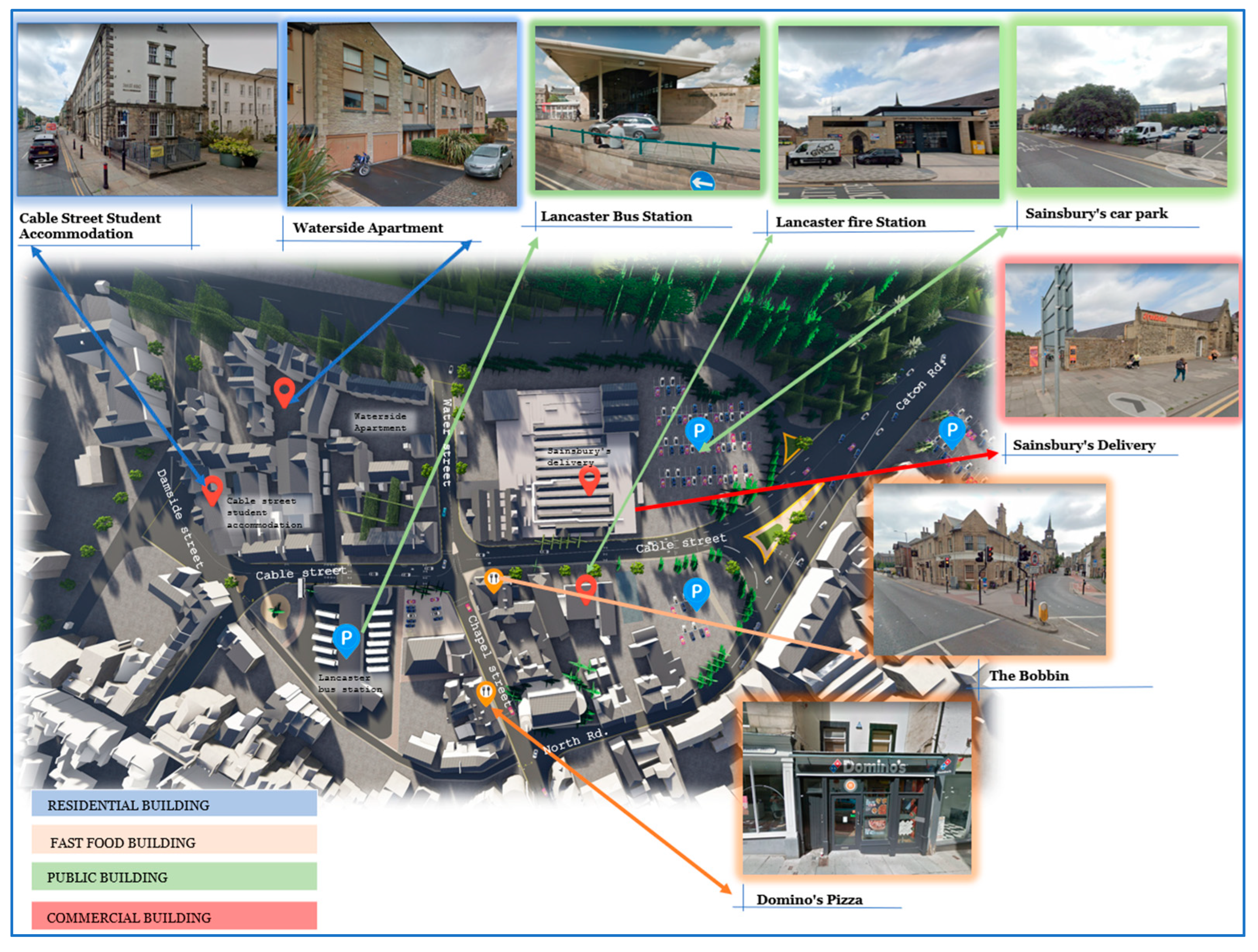
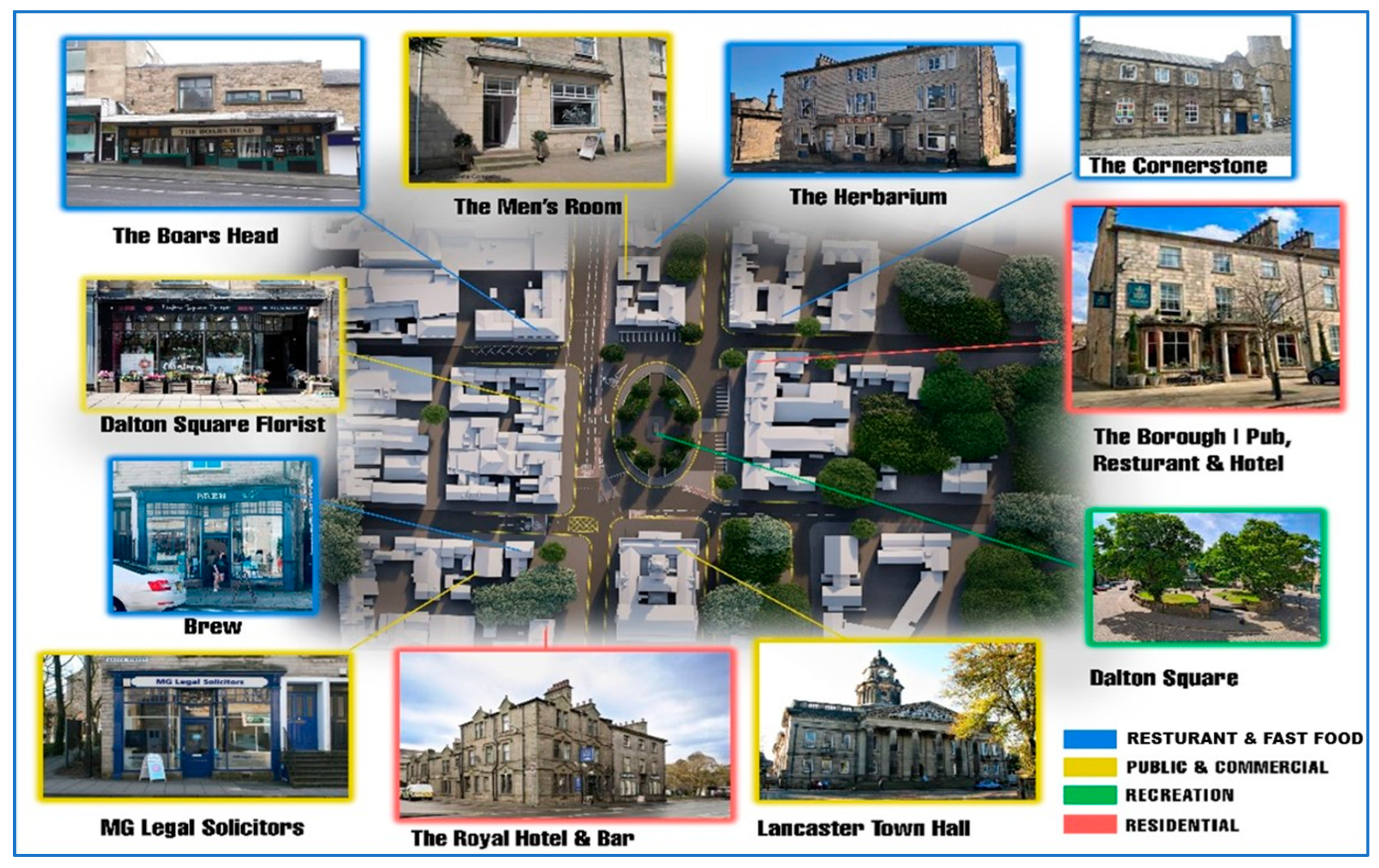
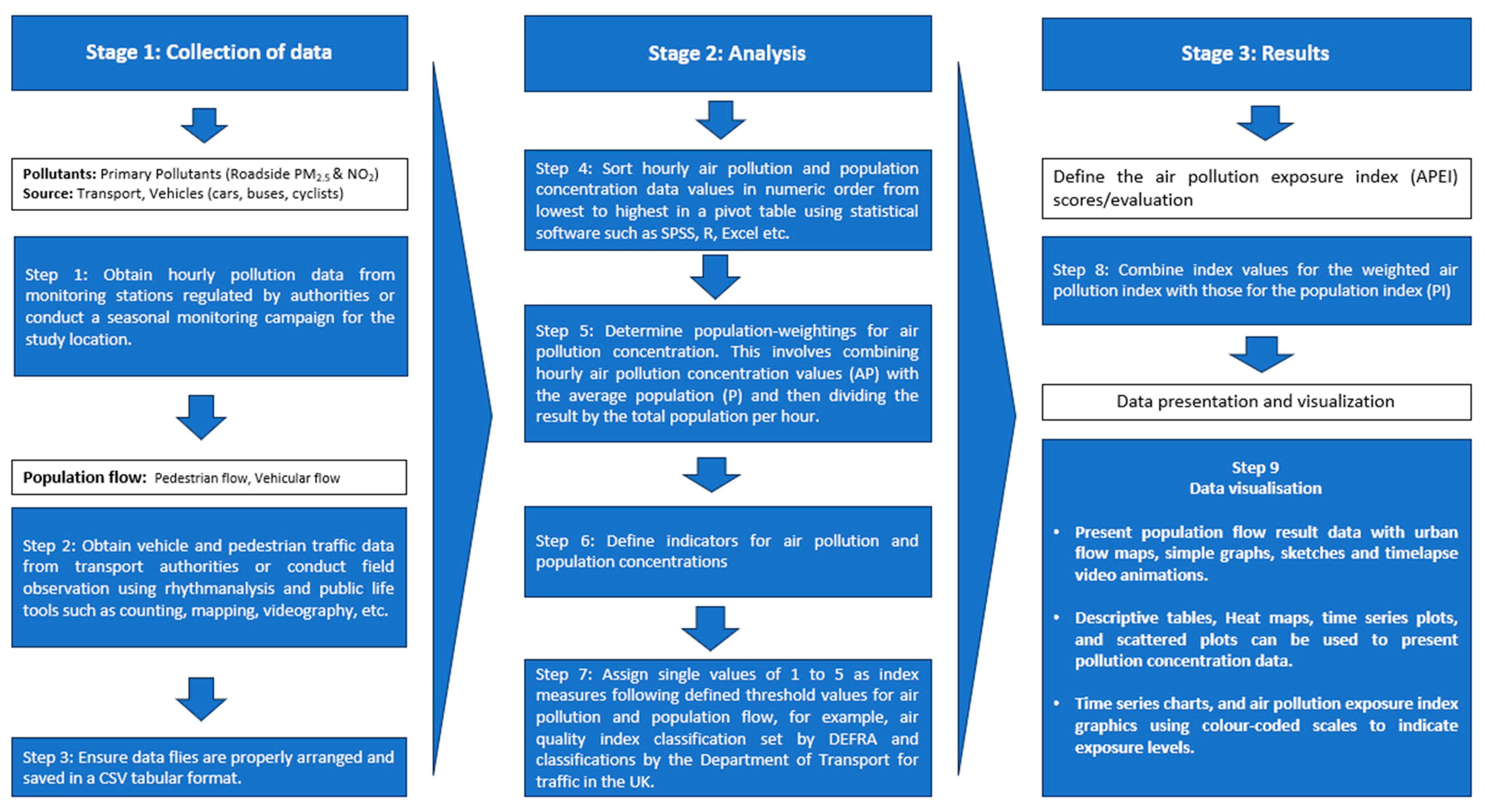
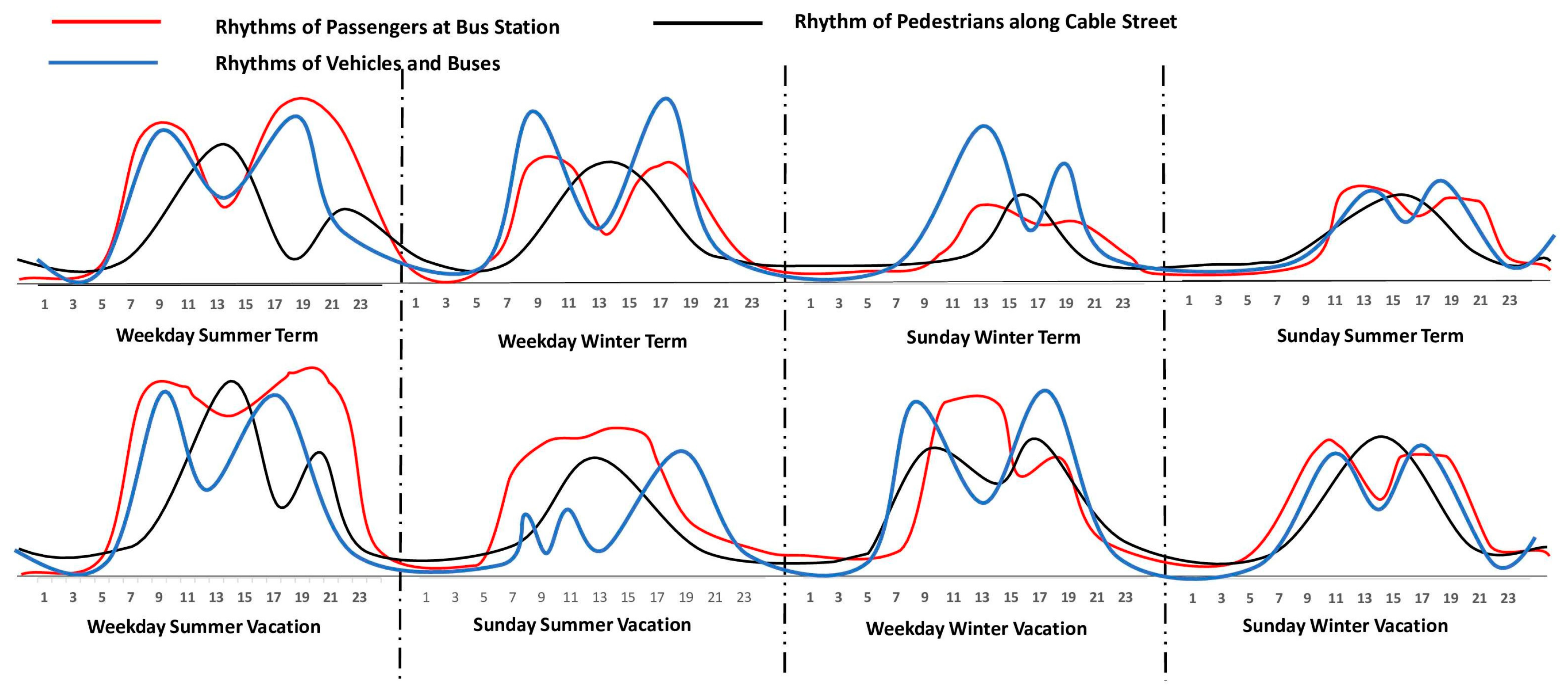
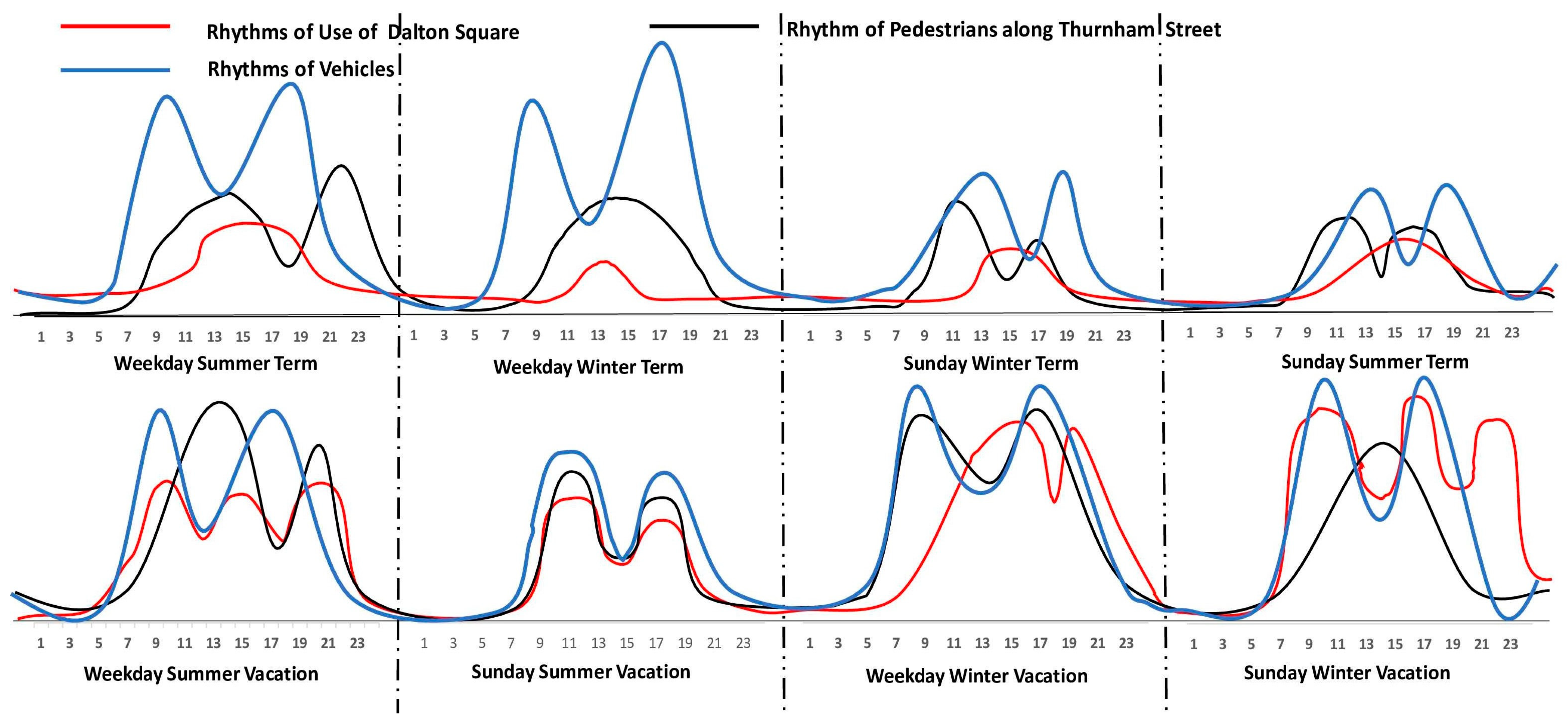



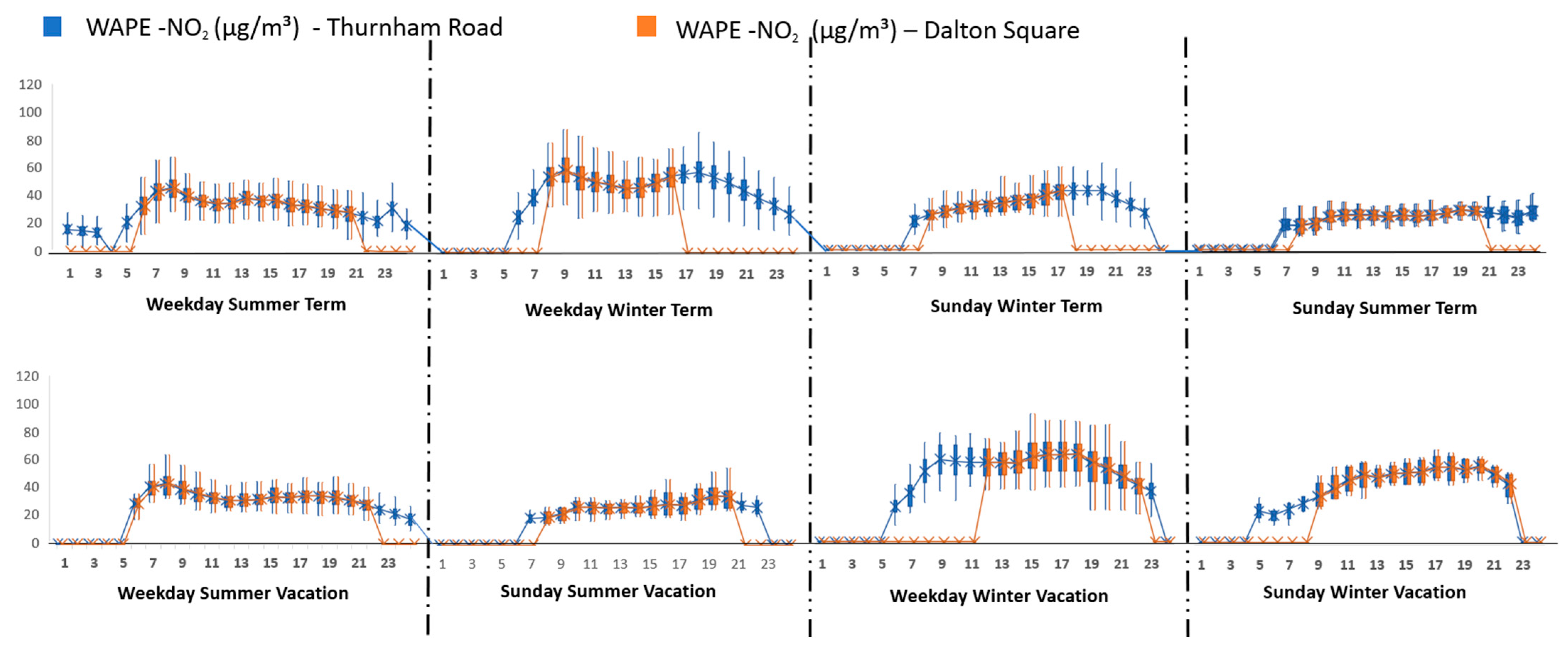

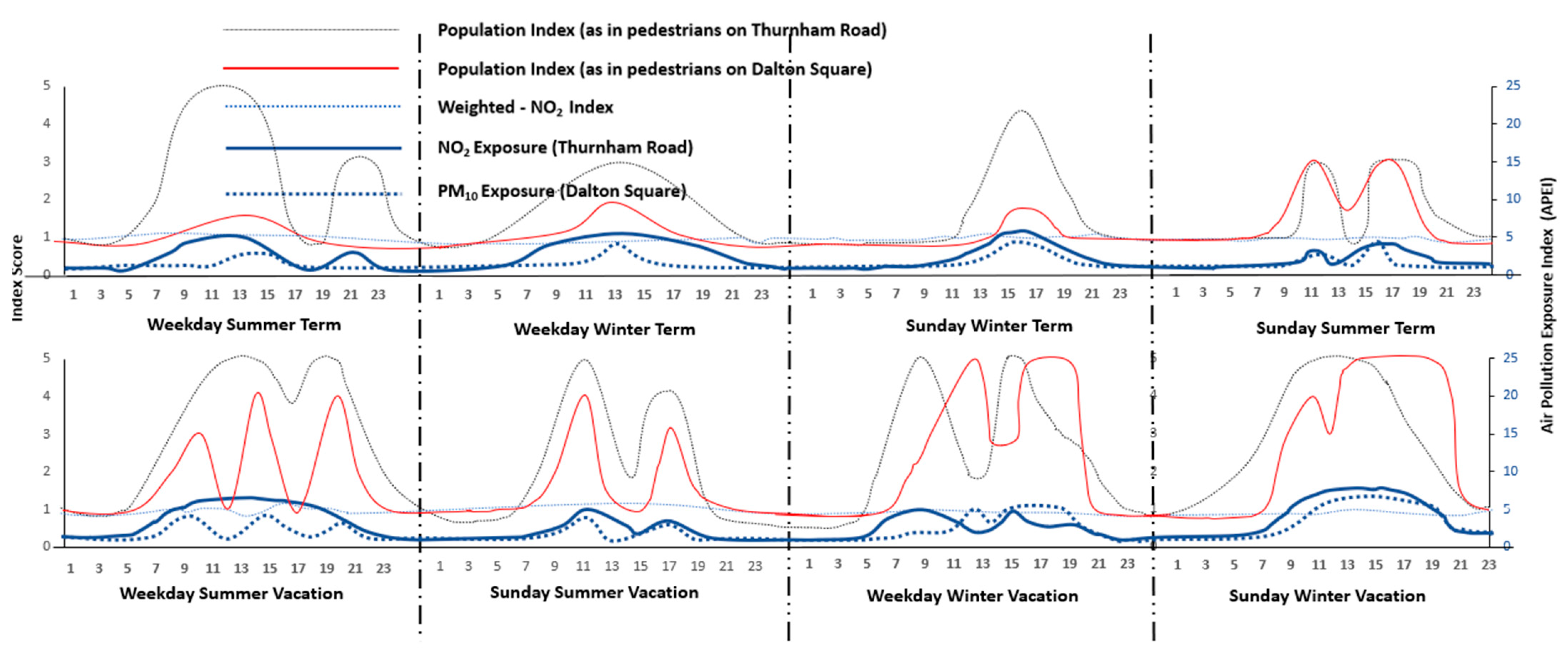
| Population Index | 1 | 2 | 3 | 4 | 5 |
|---|---|---|---|---|---|
| Category | Very Low | Low | Moderate | High | Very High |
| Pedestrians per hour | 0–180 | 181–360 | 361–540 | 541–720 | 721 or more |
| Vehicles per hour | 0–417 | 418–834 | 835–1251 | 1252–1668 | 1669 or more |
| Percentile | 1–20% | 20–40% | 40–60% | 60–80% | 80–100% or more |
| Index | 1 | 2 | 3 | 4 | 5 | 6 | 7 | 8 | 9 | 10 |
|---|---|---|---|---|---|---|---|---|---|---|
| Band/Category | Low | Low | Low | Moderate | Moderate | Moderate | High | High | High | Very High |
| NO2 (µg/m3) | 0–67 | 68–134 | 135–200 | 201–267 | 268–334 | 335–400 | 401–467 | 468–534 | 535–600 | 601 or more |
| PM10 (µg/m3) | 0–16 | 17–33 | 34–50 | 51–58 | 59–66 | 67–75 | 76–83 | 84–91 | 92–100 | 101 or more |
| Air Quality Index (AQI) | 1 | 2 | 3 | 4 | 5 |
|---|---|---|---|---|---|
| Category | Very Low | Low | Moderate | High | Very High |
| NO2 (µg/m3) | 0–67 | 68–200 | 201–400 | 401–600 | 601 or more |
| PM10 (µg/m3) | 0–16 | 17–50 | 51–75 | 76–100 | 100 or more |
| Air Pollution Exposure Index and Risk | Description | |
|---|---|---|
| 1–5 | Very Low Exposure | Combination of any of the following: Low pollution and very low population; very low pollution and very low population; low pollution and low population; very low pollution and low population; very high pollution and very low population; very low pollution and high pollution; moderate pollution and very low population; very low pollution and moderate population. |
| 6–10 | Low Exposure | Combination of any of the following: low pollution and moderate population; moderate pollution and low population; high pollution and low population; low pollution and high population; very high pollution and low population; low pollution and very high population; moderate pollution and moderate population. |
| 11–15 | Moderate | Combination of any of the following: moderate pollution and high population; high pollution and moderate population; moderate pollution and very high population; very high pollution and moderate population. |
| 16–20 | High Exposure Risk | Combination of any of the following: high pollution and high population; high pollution and very high population. |
| 21–25 | Very High Exposure Risk | Combination of very high pollution and very high population. |
| Exposure Risk Categories | Air Pollution Exposure Index (APEI) | Frequency of Occurrences During the Day (in %) | |||||||||||||||
|---|---|---|---|---|---|---|---|---|---|---|---|---|---|---|---|---|---|
| Weekday Summer Term | Weekday Winter Term | Sunday Winter Term | Sunday Summer Term | Weekday Summer Vacation | Sunday Summer Vacation | Weekday Winter Vacation | Sunday Winter Vacation | ||||||||||
| NO2 | PM10 | NO2 | PM10 | NO2 | PM10 | NO2 | PM10 | NO2 | PM10 | NO2 | PM10 | NO2 | PM10 | NO2 | PM10 | ||
| Very Low Exposure | 1–5 | 100 | 80.4 | 100 | 91.7 | 100 | 100 | 100 | 100 | 100 | 58.3 | 100 | 95.8 | 100 | 91.7 | 79.2 | 75 |
| Low Exposure | 6–10 | 00 | 16.6 | 00 | 8.3 | 00 | 00 | 00 | 00 | 00 | 41.6 | 00 | 4.2 | 00 | 8.3 | 20.8 | 25 |
| Moderate Exposure | 11–15 | 00 | 00 | 00 | 00 | 00 | 00 | 00 | 00 | 00 | 00 | 00 | 00 | 00 | 00 | 00 | 00 |
| High Exposure | 16–20 | 00 | 00 | 00 | 00 | 00 | 00 | 00 | 00 | 00 | 00 | 00 | 00 | 00 | 00 | 00 | 00 |
| Very High Exposure | 21–25 | 00 | 00 | 00 | 00 | 00 | 00 | 00 | 00 | 00 | 00 | 00 | 00 | 00 | 00 | 00 | 00 |
| Population Categories | Index Score | Pedestrian Population (Pedestrians per Hour) | Frequency of Occurrences During the Day (in %) | |||||||
|---|---|---|---|---|---|---|---|---|---|---|
| Weekday Summer Term | Weekday Winter Term | Sunday Winter Term | Sunday Summer Term | Weekday Summer Vacation | Sunday Summer Vacation | Weekday Winter Vacation | Sunday Winter Vacation | |||
| Very Low Population | 1 | 0–180 | 54.2 | 58.3 | 87.5 | 79.2 | 37.5 | 68.5 | 50.0 | 45.8 |
| Low Population | 2 | 181–360 | 43 | 39.2 | 12.5 | 20.8 | 42.3 | 28 | 38.2 | 29.2 |
| Moderate Population | 3 | 361–540 | 3 | 2.5 | 00 | 00 | 16.0 | 3.5 | 8.3 | 20.8 |
| High Population | 4 | 541–720 | 00 | 00 | 00 | 00 | 4.2 | 00 | 3.5 | 2.2 |
| Very High Population | 5 | 721 and more | 00 | 00 | 00 | 00 | 00 | 00 | 00 | 2.0 |
| Air Quality Categories | Index Score | NO2 Conc. Value µg/m3 | PM10 Conc. Value µg/m3 | Frequency of Occurrences During the Day (in %) | |||||||||||||||
|---|---|---|---|---|---|---|---|---|---|---|---|---|---|---|---|---|---|---|---|
| Weekday Summer Term | Weekday Winter Term | Sunday Winter Term | Sunday Summer Term | Weekday Summer Vacation | Sunday Summer Vacation | Weekday Winter Vacation | Sunday Winter Vacation | ||||||||||||
| NO2 | PM10 | NO2 | PM10 | NO2 | PM10 | NO2 | PM10 | NO2 | PM10 | NO2 | PM10 | NO2 | PM10 | NO2 | PM10 | ||||
| Very Low Pollution | 1 | 0–67 | 0–16 | 100 | 8.4 | 100 | 27.5 | 100 | 14.4 | 88.3 | 14 | 100 | 23.2 | 100 | 65.7 | 100 | 24.2 | 54.2 | 45.7 |
| Low Pollution | 2 | 68–134 | 17–50 | 00 | 91.6 | 00 | 72.5 | 00 | 85.5 | 16.7 | 96 | 00 | 76.8 | 00 | 34.3 | 00 | 75.8 | 45.8 | 54.3 |
| Moderate Pollution | 3 | 201–400 | 51–75 | 00 | 00 | 00 | 00 | 00 | 00 | 00 | 00 | 00 | 00 | 00 | 00 | 00 | 00 | 00 | 00 |
| High Pollution | 4 | 401–600 | 76–100 | 00 | 00 | 00 | 00 | 00 | 00 | 00 | 00 | 00 | 00 | 00 | 00 | 00 | 00 | 00 | 00 |
| Very High Pollution | 5 | > 601 | > 101 | 00 | 00 | 00 | 00 | 00 | 00 | 00 | 00 | 00 | 00 | 00 | 00 | 00 | 00 | 00 | 00 |
Disclaimer/Publisher’s Note: The statements, opinions and data contained in all publications are solely those of the individual author(s) and contributor(s) and not of MDPI and/or the editor(s). MDPI and/or the editor(s) disclaim responsibility for any injury to people or property resulting from any ideas, methods, instructions or products referred to in the content. |
© 2024 by the authors. Licensee MDPI, Basel, Switzerland. This article is an open access article distributed under the terms and conditions of the Creative Commons Attribution (CC BY) license (https://creativecommons.org/licenses/by/4.0/).
Share and Cite
Otu, E.; Ashworth, K.; Tsekleves, E. Rhythm of Exposure in Town Centres: A Case Study of Lancaster City Centre. Environments 2024, 11, 132. https://doi.org/10.3390/environments11070132
Otu E, Ashworth K, Tsekleves E. Rhythm of Exposure in Town Centres: A Case Study of Lancaster City Centre. Environments. 2024; 11(7):132. https://doi.org/10.3390/environments11070132
Chicago/Turabian StyleOtu, Ekpo, Kirsti Ashworth, and Emmanuel Tsekleves. 2024. "Rhythm of Exposure in Town Centres: A Case Study of Lancaster City Centre" Environments 11, no. 7: 132. https://doi.org/10.3390/environments11070132
APA StyleOtu, E., Ashworth, K., & Tsekleves, E. (2024). Rhythm of Exposure in Town Centres: A Case Study of Lancaster City Centre. Environments, 11(7), 132. https://doi.org/10.3390/environments11070132










